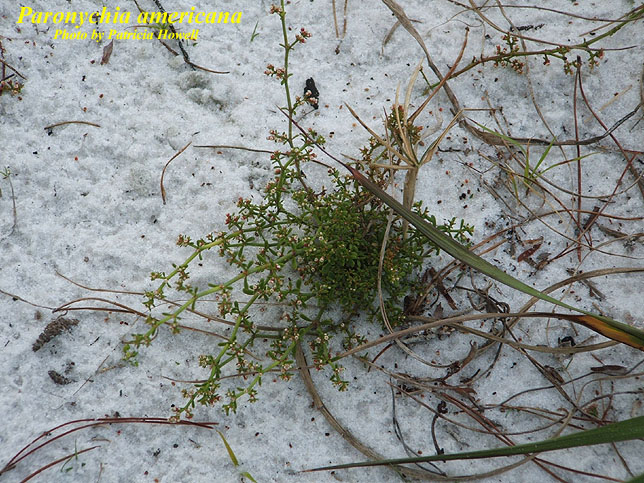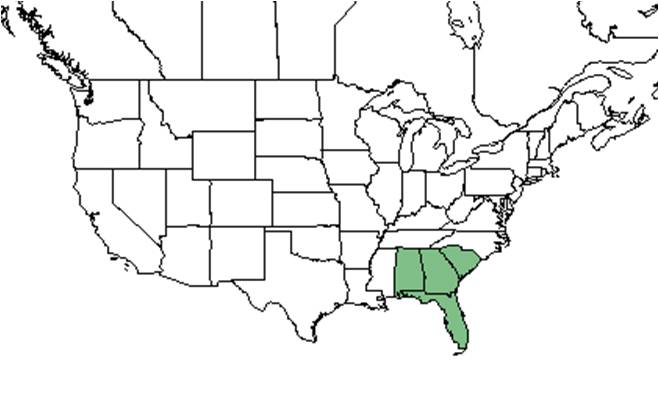Difference between revisions of "Paronychia americana"
Emmazeitler (talk | contribs) |
|||
| Line 20: | Line 20: | ||
Common names: American nailwort; American whitlow-wort | Common names: American nailwort; American whitlow-wort | ||
==Taxonomic notes== | ==Taxonomic notes== | ||
| − | Synonyms: | + | Synonyms: ''Siphonychia americana'' (Nuttall) Torrey & Gray; ''Siphonychia pauciflora'' Small.<ref name="weakley">Weakley, A.S. 2015. Flora of the southern and mid-atlantic states. Working Draft of 21 May 2015. University of North Carolina at Chapel Hill, Chapel Hill, North Carolina.</ref> |
| + | |||
| + | Varieties: none.<ref name="weakley">Weakley, A.S. 2015. Flora of the southern and mid-atlantic states. Working Draft of 21 May 2015. University of North Carolina at Chapel Hill, Chapel Hill, North Carolina.</ref> | ||
==Description== | ==Description== | ||
<!-- Basic life history facts such as annual/perrenial, monoecious/dioecious, root morphology, seed type, etc. --> | <!-- Basic life history facts such as annual/perrenial, monoecious/dioecious, root morphology, seed type, etc. --> | ||
A description of ''Paronychia americana'' is provided in [http://efloras.org/florataxon.aspx?flora_id=1&taxon_id=250060669 The Flora of North America]. | A description of ''Paronychia americana'' is provided in [http://efloras.org/florataxon.aspx?flora_id=1&taxon_id=250060669 The Flora of North America]. | ||
| + | |||
| + | ''P. americana'' is a sprawling, ascending, or erect annual. Leaves are elliptic or spatulate, 4-18 mm long, and 1-2.5 mm wide, with usually conspicuous stipules. The calyx is purple with a pubescent and globose tube. The tube is 0.5 mm long with 0.5 mm long calyx lobes. The sepals are white-scarious-margined, broadly rounded, and hooded. There is a densely pubescent on the basal portion of the sepals and this portion is nearly ½ its length. The stem is glabrous or has one side with curly hairs.<ref name="weakley">Weakley, A.S. 2015. Flora of the southern and mid-atlantic states. Working Draft of 21 May 2015. University of North Carolina at Chapel Hill, Chapel Hill, North Carolina.</ref><ref name="radford">Radford, A. E., Ahles, H. E., & Bell, C. R. (1968). Manual of the vascular flora of the Carolinas. Chapel Hill: University of North Carolina Press.</ref> | ||
| + | |||
==Distribution== | ==Distribution== | ||
| + | The species ranges from southern South Carolina to Georgia and southern Florida.<ref name="weakley">Weakley, A.S. 2015. Flora of the southern and mid-atlantic states. Working Draft of 21 May 2015. University of North Carolina at Chapel Hill, Chapel Hill, North Carolina.</ref> | ||
==Ecology== | ==Ecology== | ||
===Habitat=== <!--Natural communities, human disturbed habitats, topography, hydrology, soils, light, fire regime requirements for removal of competition, etc.--> | ===Habitat=== <!--Natural communities, human disturbed habitats, topography, hydrology, soils, light, fire regime requirements for removal of competition, etc.--> | ||
| Line 32: | Line 38: | ||
===Phenology=== <!--Timing off flowering, fruiting, seed dispersal, and environmental triggers. Cite PanFlora website if appropriate: http://www.gilnelson.com/PanFlora/ --> | ===Phenology=== <!--Timing off flowering, fruiting, seed dispersal, and environmental triggers. Cite PanFlora website if appropriate: http://www.gilnelson.com/PanFlora/ --> | ||
| − | + | This species flowers from June through September.<ref name="weakley">Weakley, A.S. 2015. Flora of the southern and mid-atlantic states. Working Draft of 21 May 2015. University of North Carolina at Chapel Hill, Chapel Hill, North Carolina.</ref> | |
<!--===Seed dispersal===--> | <!--===Seed dispersal===--> | ||
Revision as of 17:40, 2 October 2020
| Paronychia americana | |
|---|---|

| |
| Photo by Patricia Howell, Atlas of Florida Vascular Plants | |
| Scientific classification | |
| Kingdom: | Plantae |
| Division: | Magnoliophyta - Flowering plants |
| Class: | Magnoliopsida – Dicotyledons |
| Order: | Caryophyllales |
| Family: | Caryophyllaceae |
| Genus: | Paronychia |
| Species: | P. americana |
| Binomial name | |
| Paronychia americana (Nutt.) Fenzl ex Walp. | |

| |
| Natural range of Paronychia americana from USDA NRCS Plants Database. | |
Common names: American nailwort; American whitlow-wort
Contents
Taxonomic notes
Synonyms: Siphonychia americana (Nuttall) Torrey & Gray; Siphonychia pauciflora Small.[1]
Varieties: none.[1]
Description
A description of Paronychia americana is provided in The Flora of North America.
P. americana is a sprawling, ascending, or erect annual. Leaves are elliptic or spatulate, 4-18 mm long, and 1-2.5 mm wide, with usually conspicuous stipules. The calyx is purple with a pubescent and globose tube. The tube is 0.5 mm long with 0.5 mm long calyx lobes. The sepals are white-scarious-margined, broadly rounded, and hooded. There is a densely pubescent on the basal portion of the sepals and this portion is nearly ½ its length. The stem is glabrous or has one side with curly hairs.[1][2]
Distribution
The species ranges from southern South Carolina to Georgia and southern Florida.[1]
Ecology
Habitat
Paronychia americana can occur in sandhills, sand pine scrubs, turkey oak woods, wiregrass savannas, and grassy recreation fields. [3] Associated species include sand pine, live oak, turkey oak, bluejack oak, and wiregrass. [3]
Phenology
This species flowers from June through September.[1]
Pollination
The following Hymenoptera families and species were observed visiting flowers of Paronychia americana at Archbold Biological Station: [4]
Halictidae: Lasioglossum nymphalis, L. placidensis
Vespidae: Leptochilus krombeini
Conservation and management
Cultivation and restoration
Photo Gallery
References and notes
- ↑ 1.0 1.1 1.2 1.3 1.4 Weakley, A.S. 2015. Flora of the southern and mid-atlantic states. Working Draft of 21 May 2015. University of North Carolina at Chapel Hill, Chapel Hill, North Carolina.
- ↑ Radford, A. E., Ahles, H. E., & Bell, C. R. (1968). Manual of the vascular flora of the Carolinas. Chapel Hill: University of North Carolina Press.
- ↑ 3.0 3.1 Florida State University Robert K. Godfrey Herbarium database. URL: http://herbarium.bio.fsu.edu. Last accessed: October 2015. Collectors: Loran C. Anderson, Michael B. Brooks, George R. Cooley, Bob Fewster, Robert K. Godfrey, Mike Jenkins, Walter Judd, R. Kral, Sidney McDaniel, Marc Minno, Joseph Monachino, Cecil R. Slaughter, Bian Tan, R.L. Wilbur. States and Counties: Alabama: Pike. Florida: Brevard, Collier, Columbia, Hernando, Flagler, Lake, Leon, Palm Beach. Georgia: Emanuel, Laurens, Telfair. Compiled by Tall Timbers Research Station and Land Conservancy.
- ↑ Deyrup, M.A. and N.D. 2015. Database of observations of Hymenoptera visitations to flowers of plants on Archbold Biological Station, Florida, USA.